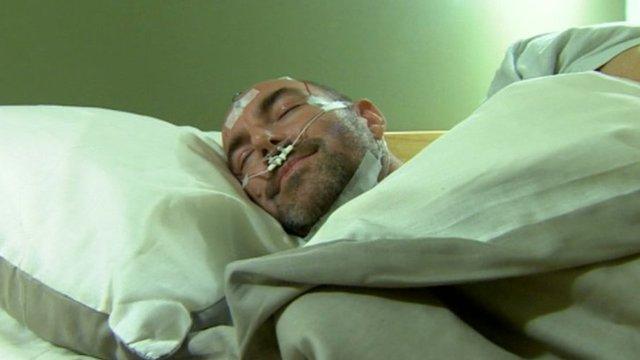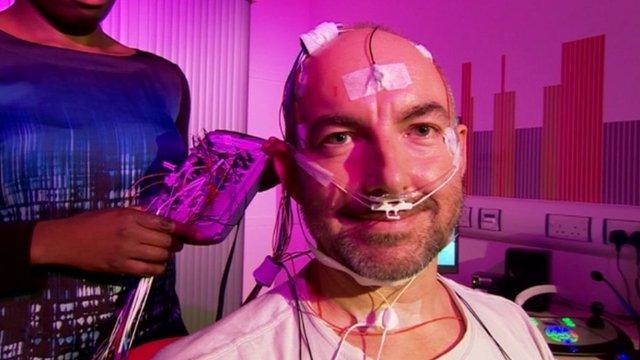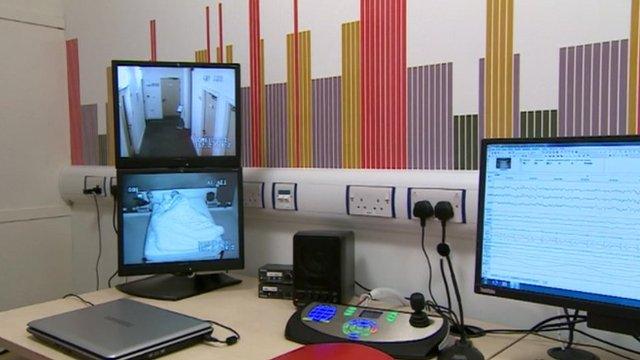My night testing out a brand new sleep laboratory
- Published
- comments

I am one of the university's early test subjects
I'm trying to go to sleep.
I am lying in a very comfortable bed. There is the calming white-noise of air conditioning somewhere. I could be in any modern hotel.
Cool, green paint on one wall. Nice carpet. Anonymous painting by the door. Posh shampoo in the bathroom.
But there is no television. Although, there is a CCTV camera in the ceiling watching my every move.
I also have a mass of wires attached to me monitoring everything from leg movements, to brain waves and my heart rate.
When I sleep tonight my every move will be watched, my body's every twitch, thought and eye roll will be recorded.
Welcome to my night in the University of Warwick's sleep laboratory.
Bundle of cables
It has taken two years to design and build and the aim is to try to understand much more about how we sleep and why some of us have so much difficulty nodding off in the first place.
I am one of the early test subjects.
There are other sleep labs in the UK. In fact, there is a big one at Heartlands Hospital in Birmingham, but they are mainly concerned with treating people with problems that are directly interfering with their shut eye.
Conditions like sleep apnoea, where the walls of the throat relax at night and interrupt breathing.
At Warwick they are doing something much more fundamental - real in-depth analysis of what happens when we sleep.

Being attached to so many wires made it hard to drop off
That involves monitoring a huge number of variables - which explains why I am currently lying in bed with a big bundle of cables stretching from me to a panel on the wall under the watchful eye of CCTV, with a scientist next door keeping me company all night while I sleep.
Or at least, while I try to sleep.
The researchers have gone out of their way to make this a pleasant experience.
The room really does look like an upmarket business hotel, and there is plenty of soundproofing and a big solid blackout curtain.
But you are hooked up to a lot of sensors - two on each leg, two monitoring my heart on my chest and more than I could count on my head.
There are also two straps running right round my upper body to monitor my breathing and my position.
All have wires that run to a box on the wall which I can detach and take with me to the rather nice bathroom if I need to answer the call of nature in the night.
Time for bed
It is hard to relax when you are worried about tearing a vital sensor from your scalp. Still sleep is what I'm here for.
I drop off.
I think, because I'm so aware I'm being watched and recorded, I become very conscious of my sleep.
I have three really intense periods of dreaming which not surprisingly involve dreams where I'm wired up to plenty of cables.
I am also aware that I do lots of wakeful tossing and turning. But by the time our camera crew turns up in the morning I'm actually deep asleep and the team have to gently wake me up.

The equipment helped chart my sleep pattern
Perhaps not surprisingly my results show someone who is having trouble dropping off. But the graph also shows periods of rapid eye movement or REM sleep, often associated with dreaming and also periods of deep sleep too.
In a real experiment, subjects are invited to attend a second session where they often have a more typical slumber as they are used to the procedure and the equipment.
Sleep and pain
Each night produces an enormous amount of data for the scientists to analyse.
At the moment they are particularly interested in using their brand new lab to study ordinary deep sleepers and also people who have trouble sleeping because they have painful conditions like fibromyalgia.
The idea is to try and untangle how pain and a lack of sleep are connected.
You might think it is as simple as pain keeping people awake but there is a lot more going on.
For example patients might experience poor quality of sleep because they are worried pain could wake them up.
Being aware of a painful condition and its potential to disrupt sleep can cause insomnia all by itself.
The eventual aim is to offer new ways to treat insomnia in patients. In the meantime I'm off for some porridge and a strong cup of coffee.
If you want to volunteer to take part in the work of the University of Warwick's new sleep laboratory you can read more about the lab here , externaland apply to be a subject here, external. Or leave the team a voicemail on 02476 528294 expressing your interest and leaving your contact details.